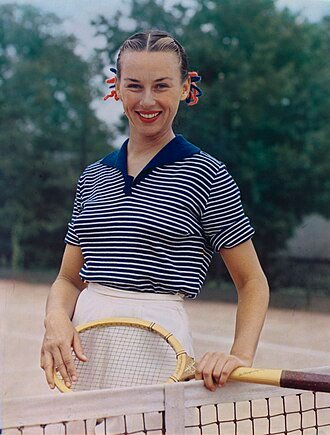Gussie Moran and Her Bold Fashion Choice
Gussie Moran, a prominent tennis star in the 1940s, made an indelible mark on the history of Wimbledon with her audacious fashion choice on June 20th, 1949. Known for her competitive spirit and distinctive style, Moran’s decision to wear a short dress during the prestigious tournament was both a personal statement and a groundbreaking move in the world of tennis. Her primary motivation was straightforward: she desired to combine aesthetics with functionality, aiming to “look good and move more freely on the court.”
To bring her vision to life, Moran collaborated with renowned designer Ted Tinling, who was well-versed in both fashion and the specific demands of tennis attire. Together, they designed a dress that was not only innovative but also practical. The white dress featured a short hemline, which was a stark departure from the conventional longer skirts that dominated the tennis courts of that era. This bold design allowed Moran greater mobility, aligning perfectly with her athletic needs and aesthetic preferences.
The historical context of the period underscores the revolutionary nature of Moran’s choice. During the late 1940s, tennis attire was predominantly conservative, with players adhering to strict dress codes that emphasized modesty and tradition. Moran’s short dress, therefore, represented a significant shift, challenging the norms and sparking a dialogue about the role of fashion in sports.
Initial reactions to Moran’s attire were mixed. While some applauded her for her courage and foresight, others criticized her for defying tradition. Quotes from contemporary interviews reveal that Moran was fully aware of the controversy her dress would stir. She famously stated, “I don’t care what they say, I want to play looking my best.” This sentiment resonated with many, positioning her as a pioneer in advocating for athletes’ freedom to express their individuality.
The impact of Moran’s decision on the 20th of June, 1949, extended beyond the tennis court. It paved the way for future generations of female athletes to explore and embrace fashion as an integral part of their identity, thereby forever altering the landscape of sports attire.
Impact and Legacy of Gussie Moran’s Fashion Statement
The events of 20th June 1949, when Gussie Moran shocked Wimbledon with her daring tennis attire, sparked immediate and wide-ranging reactions. Moran’s choice to wear a short skirt and lace-trimmed knickers designed by renowned tennis fashion designer Ted Tinling was both revolutionary and controversial. The traditional Wimbledon crowd was divided, with some expressing admiration for Moran’s boldness, while others decried the outfit as scandalous and inappropriate for the prestigious tournament.
Sports commentators of the time were quick to weigh in, with many critiquing the outfit as a distraction from the sport itself. Traditionalists, who held Wimbledon as a bastion of conservative values, were particularly vocal in their disapproval, arguing that Moran’s fashion statement undermined the decorum of the game. However, the controversy also brought significant media attention, propelling both Moran and the conversation around women’s sportswear into the global spotlight.
Historically, Moran’s attire was a catalyst for change in women’s athletic apparel. It challenged societal norms and pushed the boundaries of what was deemed acceptable for women in sports. By prioritizing both functionality and fashion, Moran’s outfit contributed to a broader movement towards greater freedom and self-expression in women’s sportswear. This pivotal moment in fashion history is often cited by scholars and historians as a significant step towards the modern, more liberated approach to athletic apparel for women.
Expert opinions underscore the importance of this event in the context of women’s rights and fashion history. Scholarly articles and historical records demonstrate that Moran’s bold choice was not just about a single outfit but represented a shift towards greater autonomy and expression for female athletes. Documentary sources further illustrate the cultural impact of Moran’s statement, highlighting how it resonated beyond the tennis court and contributed to ongoing discussions about gender and fashion.
Gussie Moran’s legacy continues to influence modern athletic apparel. Contemporary athletes have embraced and expanded upon her pioneering spirit, often donning outfits that combine performance with personal style. From Serena Williams’ tutu at the 2018 US Open to the colorful, custom-designed outfits seen in various sports today, the echoes of Moran’s 1949 Wimbledon shockwave are evident. Her impact is a testament to the enduring power of challenging norms and advocating for self-expression through fashion in sports.

